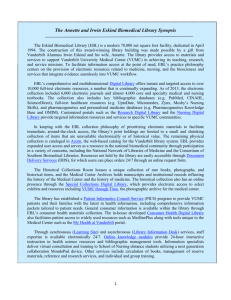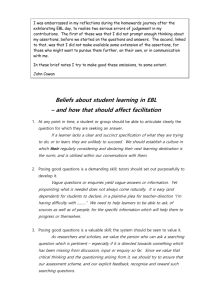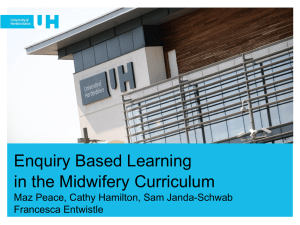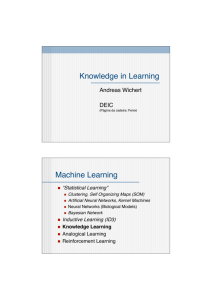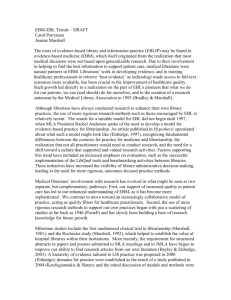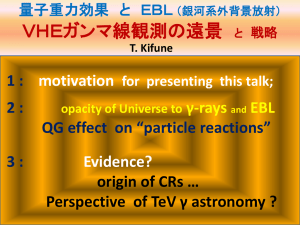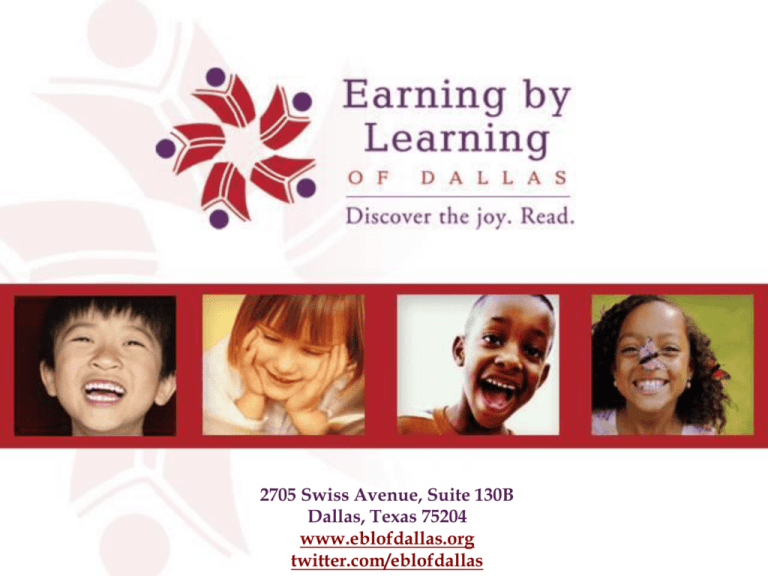
2705 Swiss Avenue, Suite 130B
Dallas, Texas 75204
www.eblofdallas.org
twitter.com/eblofdallas
TRAINING MANUAL FOR
COORDINATORS &
ADMINISTRATORS
www.eblofdallas.org
Can we just read please?
Contributors
Thelma Morris-Lindsey, Executive Director
Earning by Learning
Gloria H. Lett
Educational Consultant
Elnora Smith
Educational Consultant
Copyright Notice
Copyright Notice
Copyright 2007, Earning by Learning of Dallas, Inc., All Rights Reserved.
This publication is protected by U.S. and international copyright laws. It is unlawful to duplicate or
reproduce any copyrighted material without authorization from the copyright holder. For more
information, contact Earning by Learning of Dallas, Inc. at the address shown below.
The EBL logo is the trademark of Earning by Learning, pending registration in the United States
and abroad.
Earning by Learning of Dallas
2705 Swiss Avenue, Suite 130B
Dallas, Texas 75204
214-827-1777 (office)
214-827-1785 (fax)
Contents
Preface
1. The Earning by Learning Program
Introduction
Vision and Mission
How the program works
“Incentivizing”
Our Notion
Motivating Factors
Program Setup
Campus Selection
Selection of the In-School Coordinator
Criteria
Essentials
Task Checklist
Promoting EBL
Book Inventory
Organize Book Inventory 1…2
Hardware
Program Implementation
Selecting Students
1…2…3
Scheduling
1…2
Curricular Integration
Management
1…2
Program Accountability
Reporting
What Campuses Do To Enhance the EBL Experience
Kickoffs and Celebrations
1…2
Support Services
Solicit Community Stakeholders Involvement
“Hitting the Wall”
1…2
Preparation for the Second Session
Principal’s Notes
Pre-Plan
Assess Resources
1…2
Site Based Decision Making Team
1…2
Innovative Programs
Statistics
Glossary
Contents
2. Program Timeline
3. Rationale
1…2…3…4…5
4. Philosophy
1…2…3…4…5
5. Executive Summary
Our Service Area
Our Incentive Program
Reading Outside the Classroom
Bookrageous Bookmobile
Where We Get Our Money
The EBL Team
A National Emergency
1…2
Prevention is Better than Intervention 1…2
6. Evaluations/Outcomes/Measurements
Harvard University
We’re About RESULTS
Preface
Have you experienced the wide-eyed anticipation of a young child on the first day of school?
And have you seen the excitement and joy in those same eyes when they realize that they
can read? Given the many academic challenges elementary aged students encounter in
today’s classrooms, and the seemingly endless testing to access their aptitude and
academic growth, it is quite possible that children and community stakeholders might ask:
“Can we just read please?” Thus the title of this publication was conceived.
Can we just read please? is a training manual designed to guide coordinators,
administrators, and teachers through the process of organizing, setting up, implementing
and managing Earning by Learning (“EBL”) for elementary school aged children and youth.
The manual is for those who believe that reading is an inalienable right and a passport to a
better life for our children: written by three educators whose collective perspective
represents more than a decade of successful Earning by Learning program implementation.
Introduction
Earning by Learning (“EBL”) is a free
voluntary reading program that provides
elementary school aged students
opportunities to read at their readability
level while reading high interest books.
Students are offered a $1 incentive for
every book read (up to 20 books) and
must pass a reading comprehension quiz
with a score of 80% or greater. During the
school year, over 50 Dallas ISD
elementary schools will participate in the
EBL program.
Vision
To be the motivational vehicle of choice
for encouraging children to discover
the joy of reading…transforming lives.
Mission
Earning by Learning is an innovative,
research-driven program, based on
incentives encouraging children to
read.
How the Program Works
Children, grades K-6, select
titles approved by school and
center personnel and receive
$1.00 for each book they
master through Accelerated
Reader computerized reading
software programs. There are
fall and/or spring EBL
sessions offered at various
campuses. Program session
delivery depends on funding.
“Incentivizing”
Critical points:
Children
dramatically discount the future.
Beginning to plan and work for college, 10 years from
now, can be a difficult choice.
Typically, in today’s society, the average achieving
urban student may rarely see the results of their peers
having successfully navigated an education path.
We ask young urban children to dream; to plan ahead;
and choose a very uncertain path with few examples to
help guide the way: a calculation that children from
well-educated families may not be asked to make
Our Notion
Provide short-term incentives to get students to do
what is in their best interest, in the long-term. EBL
builds on the intuition that educators and parents
have had for centuries - incentives work! Although
the underpinning of the program is the provision
of a financial award, in practice, EBL believes that
the money is only the initial motivator for students
to participate in the program.
Motivating Factors
EBL observes that there appear to be other, nonmonetary, intangible factors that strongly affect
students' desire to read. Indeed, EBL's in-school
coordinators (designated by campus principals) have
long recognized constructive growth in studentparticipants'
self-efficacy;
enthusiasm for reading and learning in general;
task choice;
peer modeling;
decision-making and goal-setting;
persistence in effort;
desire to achieve success; and,
self-evaluation.
Program Setup
Campus Selection
Selection of the In-School Coordinator
Criteria
Task Checklist
Promoting EBL
Book Inventory
Organize Book Inventory
Hardware
Campus Selection
Organizational Perspective:
Prerequisites
Strong
for each campus/site
principal/director leadership
Adequate technology and software
Adequate books
Mandatory training
Desire to establish a book culture within the
school/site
Willingness to team with a university and EBL to
collect and analyze data for clearinghouse purposes.
Selection of the In-School
Coordinator
After consultation with EBL leadership, it is the
responsibility of the campus principal to select
the campus coordinator.
Select
the coordinator prior to the opening of school;
and
Allot time for sufficient, appropriate training for the
job.
Criteria
The selection should be based on, but not limited to the
following criteria.
Personnel selected should:
be organized and objective driven.
be willing to thoroughly learn the program.
be willing to dedicate appropriate before, during and after
school time for program administration.
encourage and expect student success.
have high campus visibility.
Note: The In-School Coordinator should not be assigned other
responsibilities that conflict with the administration of this
program.
Essentials
Early in the school year, the
In-School Coordinator
should expect to receive
an information packet
including a registration
form, program guidelines,
a parent/guardian
permission form and
contract, and timeline. An
electronic survey will be
provided at the close of
the session.
Task Checklist
Copy and send letter of permission home with
previously selected students.
Collect returned permission forms.
Parents/guardians must sign and return the letter in
order for students to participate. Keep all letters on
file at your campus/site.
Prepare to serve your assigned number of EBL
students in the fall and/or in the spring. (Start up
schools may be authorized to serve less students
until such time that program mastery can be
assessed.)
Promoting EBL
Publicize the power of EBL
In a memo from the In-School Coordinator, signed
by the principal, and read over the public address
system;
During staff development meetings, and
During appropriate grade level meeting.
Form an EBL team to help facilitate the program.
Book Inventory
Many of the books needed are already in your school library. Several
book vendors will be able to go into each participating school’s data base
and flag all the AR books.
Arbookfind.com is a free tool.
Increase the inventory with paperback books from your book fairs and
donations from adopters/school partners.
Build class sets from the library budget and instructional funds. New
books with the grade levels, fiction and nonfiction identification already in
place. Use major book vendors have entire catalogs that list AR books
according to specific content; science, social studies, beginning chapter
books, biographies; etc. Award winning books are readily available.
Organizing Inventory
After the AR books are appropriately flagged:
Ask for volunteer assistance from the PTA, students or any
volunteer groups functioning in the building. Request
volunteer help from your feeder schools. All Seniors need
community service hours. This is a big start up job, but if
shared, it is very manageable. Most high school students
are required to have community service hours.
On the spine of each book, place a small round neon orange
label.
Search Dallink; create a bibliography and print it. This is an
excellent search lesson in the use of Dallink.
Group two or more volunteers together
Organizing Inventory (con’t)
Have each group circle the call numbers on the
bibliography printout.
Go to the shelves, locate the books, and take them to
designated work tables.
Pencil in the reading level
Tape a bright, quarter inch book tape to the book spine or
follow the librarian’s procedures.
Have the next volunteer group or class return the identified
books to the shelves.
Repeat the process until all in-house AR titles are
identified.
Hardware
Computers with monitors. There should be at least five (5),
centrally located, and accessible computers for student use.
The computers and monitors must be in excellent working
condition and not more than five years old.
Electrical outlets accessible without excessive use of
extension cords or power strips.
Computers must be connected to the internet.
Program software must be purchased or upgraded as
prescribed by Renaissance Learning. Renaissance Place is
the online Accelerated Reader (AR) website version. Windows
XP 2000, or later is preferred. (www.renlearn.com)
A printer must be exclusively dedicated to the program and
accessible at all times.
Program Implementation
Getting Started
Selecting Students
Scheduling
Curricular Integration
Management
Selecting Students
Select students from grades K-6 or as
determined by the principal and the In-School
Coordinator—not to exceed your assigned student
number each session.
Earning by Learning suggest that you start with
2nd graders. However, you may also select upper
grade level students in the fall and lower grade
level students in the spring.
Selecting Students (con’t)
Select students with high, medium and low reading levels
Use AR Star 2 Diagnostic Assessment to determine each student’s
reading zone. For example: one 2nd grader’s reading range might
be1.5-2.5 while another 2.0-3.0. Star 2 includes norms upgrade.
New EBL schools will need to enroll and impact all participating
students into the AR program. If online AR is used, students will be
entered once, if a stand alone process is used, students must be
manually added to each computer.
Teach/re-teach students how to access AR and use the program.
Selecting Students (con’t)
Use student identification numbers as passwords. At non
school sites, create a username and password.
Choose 3 or 4 easy book titles for test practice before
the actual launch date.
Students must score 80% or greater on AR
comprehension tests to receive incentives.
Use tests only between the starting and ending dates of
the EBL session.
Scheduling
Scheduling is critical to program success: the
number of weeks; number of students; grade
levels; minimum number of books to be read, etc.
Flex library scheduling allows students access as
determined by the teacher and librarian
Special class teachers; i.e. art, music and physical
education, are encouraged to have students select titles to
support current topics in that discipline. Biographies and
other non-fiction books are excellent choices for students to
read and test.
Scheduling (con’t)
The library should be open before/after school and
during lunch.
Schedule online student comprehension testing in the
library, classroom, or computer lab. Where applicable,
consult with district policies for computer lab use.
When class requirements are complete, students
should be encouraged to receive a pass to the library to
select additional books and/or test.
Make sure all students have public library cards.
Curriculum Integration
Both narrative and expository books are appropriate for the
EBL program. The In-School Coordinator should select
books that are integrated with required grade level
curricular: art, music, social studies, history, geography,
science, exploration, inventions, etc. are encouraged as
well as other subject areas of interest to the students.
Science and social studies titles are available for student
selection so that current study topics can be supported.
Biographies and other non-fiction books are available to
support art, music, and physical education content areas.
Management
Shelves to accommodate
recommended number of books:
Reading Level
K-Grade 1
Grade 2
Grade 3-5
Grade 6-8
AR Books/Student
10
8
5
4
100 to 200 titles per grade level
will prove to be a good starting
point for most programs. Keep in
mind that the public library will
supply books needed until the
school’s inventory has reached the
desired level.
Paperback books can be placed in
magazine or storage boxes with the
reading level identification written
on the outside of the boxes.
Access to student books can be
on three tiers
Arrange books in the regular
fiction or nonfiction sections of
the library.
Have a speed zone area in the
library for books students are
able to read within a short
amount of time, yet on the
appropriate reading level. This is
where your 100 to 200 titles per
grade level will be located.
Use the campus library and the
public library can be used to
create and maintain a rich
classroom library. Update
weekly, or as often as desired.
Management (con’t)
Group books that
students are able to
read, in house, by
reading levels.
Place books on carts,
special shelf areas, and
in boxes.
Print reading log of book
titles
Check students’ progress
after the first seven (7)
days.
Interview students
regarding his/her reading
progress; 30 seconds to
one minute for each
student.
Check to see if the reading
zone needs adjusting.
Program Accountability
Students must test at 80% or
greater.
Reporting
Send diagnostic report
(includes book quizzes
passed) to EBL by date
requested.
Print report of all active
students. Encourage the
high performers to become
sturdy pace readers.
Spend small group time
with students who are
having difficulty. Use all
reading strategies for
fluency.
Students should have read at
least 10 books by the half-way
point of the session. Print all
records to monitor progress.
Check each week after half
way point.
Stop students on EBL
designated ending date.
Count students’ number of
books read and those
successfully tested at 80%.
Send AR diagnostic report to
EBL on or before due date.
Students are compensated for
reading up to 20 books and
passing the AR computerized
tests.
What campuses do to enhance the
EBL experience
During inclement weather days, make books assessable to
students in the cafeteria, auditorium, or in other designated
areas.
Issue students library passes as a reading incentive.
Help students create their own home libraries.
Help students learn financial literacy as well as giving back.
Earning by Learning will partner with others in an effort to
teach financial literacy and the art of giving back. EBL will
also provide webinars and podcasting in the future on
finance, giving back, college preparation etc.
Designate independent reading as the activity of choice!
Kickoffs & Celebrations
Kickoffs set the tone for the program. Each
campus is responsible for their kickoff. Make it
fun!
Celebrations dates are determined by EBL;
however, the campus must take ownership of
other specifics.
Publicize the celebration! (public relations
outreach to Independent School Districts,
community stakeholders, print media, radio
and television community bulletin boards,
campus websites, fliers to parents and
guardians, etc.)
Kickoffs & Celebrations (con’t)
Invited guests should include parents/guardians; funding
supporters; Sight Based Decision Making team (SBDM);
highly visible community leaders; Parent Teacher
Association (PTA), EBL campus alumni, college students,
volunteers, etc.
Recognize all participants.
Announce only the number of books read by each student
(not the dollar amount).
Support Services
Consult EBL offices for a local
Accelerated Reader representative to
assist you.
Solicit Community Stakeholder’s
Involvement
Ask them to:
Match the dollar amount for the number of books
read.
Donate computers and software.
Host a reading celebration at their workplace.
Have an employee volunteer be a guest speaker for
a campus celebration
Become a reading pal.
Sponsor a campus book drive.
Underwrite an EBL reading celebration.
Help with library needs (ie shelving , leveling etc.)
“Hitting the Wall”
What if I have to use stand alone
computers?
If using stand alone computers, print all
student records once a week. Students
must use logs to protect his/her work but
print hard copies to confirm.
What if the reading teacher will not take
the class to the library?
Work with teachers in other disciplines,
support their subject areas and keep the
EBL program moving along.
“Hitting the Wall” (con’t)
What if I don’t have
enough computers?
Line
chairs up like a train
and have students sit
and move forward
orderly. This strategy
helps to limit confusion.
Prepare for the
nd
2
Session
Ask that children read over the winter break so that when they
return to school ready to take the computerized quizzes.
Turn in a new roster if children or classes have changed.
Take the STAR 2 assessment again and measure growth.
Post the deadline to turn in all EBL documents.
Prepare for the most spectacular reading event EVER!
Provide reports for parents so that they understand their
child's reading strengths and improvement needs.
Challenge children to go beyond their comfort zone, to read
various genres of books and to learn the value of time
management.
Principal’s Notes
Pre-plan
Assess Resources
Site Based Decision Making Team
(SBDT)
Innovative Programs
Statistics
Pre-plan
It is essential that the Campus Instructional Leadership Team
(CILT), or a similar instructionally focused, decision making body,
uses pertinent campus disaggregated reading test data and
identify comprehension and fluency needs at each grade level.
Following such data examination, specific goals and objectives
must be determined and made a part of the Campus
Improvement Plan (CIP).
Next, grade level teams should examine small group and
individual student reading test data so that grade level specifics
can be ascertained.
Data that identifies individual students as borderline, and/or those who
consistently perform below expectations should be studied in detail. It is
those students who may benefit greatly from involvement in the EBL
program.
Assess Resources
Necessarily, the EBL program is limited in campus time
implementation. However it is essential that reading resources
are assessed annually.
Research indicates that a balance of fiction/non-fiction;
narrative/expository; multi-curricular, fine arts, athletic, books,
etc. is most effective.
Such reading materials, housed in high visibility areas in the
school setting, help to create a “reading culture” that can also
permeate the entire school community.
Assess Resource (con’t)
Campus leadership might also consider including each staff
member and campus volunteers as reading resources.
For example; students should be exposed to specific types of
materials cafeteria and custodian staff must read in their line of
work.
Additionally, sharing the reading interests of campus
volunteers will only heighten student interests. Such persons
can also serve as encouraging mentors for EBL students.
Site Based Decision Making Team
Site Based Decision Making Team (SBDT) –This mandated,
carefully chosen, well-balanced group of campus staff,
business leaders and volunteers is a tremendous asset
to the EBL program. The principal, having assembled the
SBDT, has the
opportunity to engage them
to their highest potential.
Reading
advocates
Monitors
Mentors
Financial supporters
Other
SBDT (Con’t)
For example: a banking officer member of the SBDT may
have his institution provide added incentives for
participating students or funding for the In-School
Coordinator. Also, a valuable business leader such as this
may well agree to contribute to the campus reading
material resources, gift take home books, computer
hardware/sofware, a school banner or marquee displayed
for the entire community to see.
It is essential that the Parent Teacher Association be a
viable part of the planning and implementation of this
program.
Innovative Programs
Look for other innovative reading projects to help
students focus on reading throughout the school
year and within their community.
Suggest that older students read to younger
students.
Statistics
The principal will want to include the EBL project as
a significant part of the 2009 -2010 campus
objectives.
For example: 100 students will read a minimum of 20
books during the fall session or 150 students will read a
minimum of 20 books during the spring session.
The principal should also pledge to read a specific
number of books during the sessions as well.
Glossary
Accelerated Reader (AR) - software
produced by Renaissance
Learning. (www.renlearn.com)
In-School Coordinator - person
responsible for campus EBL
program operations.
Dallink - library’s electronic catalog.
Diagnostic Report - the report that
provides student data for the
campus and EBL.
Expository - reading material
designed to convey information
and/or explain difficult
information.
Flag - mark or identification.
Hitting the Wall - challenges
Incentivizing - the act of encouraging
or motivating
Reading Culture - students, staff, and
administration encourage and
foster a love of reading
Speed Zone - quick reading
Stand Alone - computers not
networked
STAR - diagnostic assessment by
Renaissance Learning
Sturdy pace reader - one who is fluent
and independent.
Reading Zone - the student’s
readability level range.
Program Timeline
August
EBL packet delivered before school
starts.
3rd week of program set up
1st week of program set up
Select students and add names to AR
program.
Contact book vendor to go into campus
data base and identify all AR books
available in the library
During the EBL sessions:
2nd week of program set up
Use very easy titles to help new students
get use to accessing AR tests. Practice
only! Do not count the book for the
program.
Take vendor list and start identifying
AR books by placing small, orange,
round, neon label on each book.
Check students’ progress after the first 7
days.
Follow the reading with brief 30 seconds
to 1 minute interviews, especially for
students who need consistent
encouragement. Adjust reading zone as
necessary.
At the end of the EBL session, send
student data to EBL
Rationale
EBL students seem to grow into a love for reading, gain
self-confidence, and boost their determination to
succeed. Such non-monetary, psychic values go beyond
behaviorist learning theory to the social cognitive theory
of Bandura (1986).1
1As quoted from “Social Foundations of Thought and Action: A Social Cognitive Theory,” Englewood Cliffs, NJ:
Prentice-Hall
Rationale (con’t)
Social cognitive theory identifies self-efficacy as achievement that results
from interplay between one’s actions, thoughts and beliefs, and the
external conditions in which one lives (Bandura 1986).
Simply put, "self-efficacy refers to beliefs about one's capabilities to learn
or perform behaviors at designated levels" (Schunk 2003). Research by
Wigfield and Guthrie supports the hypothesis that self-efficacy plays a
fundamental role in motivating children to read (1997).
However, belief in one's capabilities alone will not motivate action if the
individual does not see a clear purpose to act. The connection is provided
by Eccles et al., who show that interest values (liking the activity),
attainment values (importance of the activity), and utility values
(usefulness of the activity) are intrinsic motivational aspects to those who
believe they have the ability to act (1983).
The Earning by Learning program strives to instill these very values.
Rationale (con’t)
Various researchers have shown that self-efficacy predicts students'
academic motivation and learning (see, for instance, Pajares, 1996; and,
Schunk, 1995, 1996). Eccles et al. find that "students' ability, beliefs and
expectancies for success predict their performance in mathematics and
English."2
Similarly, "Training students both to be more efficacious and to believe they
are more efficacious improves children's achievement in different subject
areas such as math and reading“3 (see Schunk, 1991; and, Schunk &
Zimmerman, 1997). The belief that “increased reading volume raises the
level of reading proficiency” is one of the basic aspects in the research of
Allington (2001).
Wigfield and Guthrie also found that individuals who have academic
achievement goals and pro-social goals are most likely to become readers
(1997).
2
As quoted from "Relations of Children's Motivation for Reading to the Amount and Breadth of Their Reading," Allan Wigfield and John
T. Guthrie, Journal of Educational Psychology, 1997, 89(3), 420-432.
3
"Relations of Children's Motivation for Reading to the Amount and Breadth of Their Reading," Allan Wigfield and John T. Guthrie,
Journal of Educational Psychology, 1997, 89(3), 420-432.
Rationale (con’t)
Schunk's research reveals a connection between a child’s feelings
of self-efficacy and “task choice, effort, persistence, and
achievement” (2003).
Additionally, Schunk shows that "social modeling, goal setting, and
self-evaluation affect self-efficacy, motivation, and learning."
To understand the interconnectedness of these behavioral
aspects, consider the relationship between task choice (goal
setting) and self-efficacy.
Researchers have found that allowing individuals to set their goals
enhances motivation and self-regulation, perhaps because self-set
goals produce higher goal commitment (Schunk, 1995).
"People do not attempt to attain what they believe is impossible.
Goals that are perceived as moderately difficult raise motivation
and convey a clear sense of progress, which raises efficacy."
Rationale (con’t)
Social modeling refers to the phenomenon of when students observe
similar peers perform a task "they are apt to believe that they, too, are
capable of accomplishing it."
Regarding goal setting, Schunk notes, "when people make a commitment
to attempt to attain a goal … [positive results from] self-evaluations of
progress [e.g., EBL's reading comprehension quizzes] raise self-efficacy
and sustain motivation."
There is substantial literature that shows that high rates of student
success have a positive and substantial impact on learning (Allington,
2001; Berliner, 1981; Denham and Lieberman, 1980; Gage and Berliner,
1992; Marliave and Filby, 1985; Rosenshine and Stevens, 1986;
Walberg, 1986).
Taken together, these studies indicate there can be a feedback effect:
Higher levels of self-efficacy can lead to higher rates of success, which, in
turn, can lead to enhanced self-efficacy.
Philosophy
Earning by Learning encourages reading by offering
financial incentives – $1 for each book read for which the
student earns a passing score (80% or above) on a
reading comprehension quiz. At the beginning of each
program, students set a goal for the number of books
he/she will read. EBL encourages children to set a goal
of 20 books.
Philosophy (con’t)
Setting high expectations/goals has been a hallmark of the
EBL model. EBL students, not parents or teachers, choose
which books to read. Task choice is a form of goal setting;
the student chooses books based on his/her feelings of
capability in reading and/or interest.
EBL believes that a student's success on quizzes and
reaching pre-set goals augments his/her self-belief in
capabilities to learn or perform at designated levels (i.e., selfefficacy).
Upon successful completion of a book and quiz, an EBL
coordinator guides the student to an appropriate "next" book,
one incrementally more challenging than before.
Philosophy (con’t)
The student's added self-confidence from prior successes can
lead him/her to strive to achieve at the higher performance
level.
Further successes enhance increasingly higher levels of belief
in self. EBL purports that by continuing this building-up
process, students become better readers, and more inclined to
appreciate and learn other academic subject matters.
The latter belief derives from research findings that indicate the
amount and breadth of children's reading contributes to their
knowledge of the world (Stanovich & Cunningham, 1993).
Moreover, Krashen's research on reading suggests that when
children read every day voluntarily, over a nine-month period
they improve their standardized test performance by almost two
grade levels (2004).
Philosophy (con’t)
Finally, Guthrie, Schafer, and Hutchinson have shown that
children who read frequently participate more in their
communities (1991). Additionally, research by McIntosh
shows that reading competence is inversely related with
problem behavior in elementary school children (2005).
EBL believes that its participants are more active in extracurricular activities and have lower rates of disciplinary
actions.
To summarize, EBL's view is that student-participants realize
higher levels of enthusiasm for reading and learning in
general, self-efficacy, goal-setting, persistence in effort, and
desire to achieve success than non-participants do.
Philosophy (con’t)
A secondary theory is that students who report higher levels of
these psychic values score higher on standardized test scores as
well as in regular coursework.
Additionally, EBL believes that subsequent to participation in the
program, students will have higher attendance rates, lower rates
of disciplinary action, and greater involvement in extra-curricular
activities.
Moreover, in the very long-term, it is believed that Earning by
Learning participants will have higher graduation rates (from high
school), and higher college enrollment rates. (It is recognized
that EBL's specific contributions to these medium and long-term
effects cannot be conclusively determined given the multitude of
other influences that affect such decisions.)
Executive Summary
Our Service Area
EBL concentrates its program operations within the Dallas Independent
School district servicing up to 68 of its elementary schools. There is an
additional 65 on our waiting list.
Earning by Learning will help approximately thousands of children
within the Dallas ISD school district discover the joy of reading. Long
term goals include continued expansion of services within Dallas ISD.
As of the fall of 2007, Earning by Learning also has a Seattle,
Washington presence in collaboration with Powerful Schools and the
Youth Tutoring Program. Middle school and high school students are
earning continuing education units converted to college tuition upon
graduation.
Our Incentive Program
To promote financial literacy, EBL partners with Inwood Bank
and BBVA Compass in our “Read and Save” program. These
banking partnerships afford each EBL student an opportunity to
open a savings account and learn about fiscal responsibility.
EBL’s “Read and Give Back” program allows children to direct
their earnings to the school libraries in the Seattle district thus
providing a tremendous source of revenue for the library. It is an
excellent way to teach our students the art of philanthropy.
The “Read and Graduate” program brings our volunteers to
reading celebrations to discuss the importance of seeking a
college degree.
Reading Outside the Classroom
EBL students are invited to special EBL reading events
throughout the year, including Celebrity Guest Read and
Reading in the Garden at the Dallas Arboretum.
EBL also offers a Summer Reading Institute held at the
University of North Texas (Dallas campus).
This program challenges students in the areas of reading
comprehension, vocabulary development, and power writing.
At the conclusion, two Summer Reading Institute students
receive UNT scholarships. It is what EBL calls “tangible hope.”
S.A.F.E (Students Advocating For
Education)
Earning by Learning students giving a mininum of
10 cents to the Earning by Learning/University of
North Texas Scholarship and Book Fund.
Students are never to young to learn how to give
back.
Bookrageous Bookmobile
Our “Bookrageous Bookmobiles”, courtesy of Don Herring
Mitsubishi travel from campus to campus. EBL volunteers
surprise students who are “caught reading.” Special
emphasis is also placed on character. Children receive
school supplies, books donated by Scholastic, and other
wonderful incentives.
Where We Get Our Money
EBL is sponsored by the Ricky Rudine Memorial Fund of the
Communities Foundation of Texas and New Car Dealers
Association of Metropolitan Dallas.
Other strategic partners include Smith Richardson
Foundation in collaboration with Harvard University,
Washngton Mutual, Don Herring Mitsubishi, The Esping
Family Foundation, The Meyer Levy Charitable Foundation,
Jean L. Karotkin, BBVA Compass, The Lightner Sams
Foundation, UnitedHealthcare, Cadbury Schwepps Americas
Beverages, Inwood Bank, The Wachovia Foundation,
Minyard/Carnival/Sack –n-Save, Northrop Grumman, The
Harold Simmons Foundation, the Foundation for Community
Empowerment, and the University of North Texas Dallas
Campus.
The EBL Team
Board of Directors
The
Dallas-Fort Worth business community plays a
strategic role in EBL’s effort to encourage reading.
The Board of Directors sets our governance policies
and lends a hand in fundraising and publicity.
Volunteers
Hundreds
of Dallas-Fort Worth residents, including
dealers and associate members of the New Car
Dealers Association, volunteer for our children.
Together, our community is reading.
A National Emergency: Still a
“Nation at Risk”
Research indicates that fewer than one of eight children, who are
failing to read at grade level by the end of first grade, will ever
catch up to grade-level reading. This explains why Texas has the
second largest number of under-educated adults in the United
States.
Here is more of what research tells us:
50%-80% of all students in literacy and basic education programs
have learning disabilities/differences.
40% of 4th grade students are reading below grade level.
Over 40 million Americans age 16 and older have significant literacy
needs.
75% of unemployed adults have reading or writing difficulties.
A National Emergency (con’t)
Among adults with low literacy skills, 43% live in poverty and 17%
receive food stamps.
American businesses are estimated to lose over $60 billion in
productivity each year due to employees’ lack of basic skills.
75% of prisoners scored in the two lowest literacy levels of the
National Adult Literacy Survey. This means that while they have some
reading and writing skills, they are not adequately equipped to
perform tasks like writing a letter, explaining an error on a credit card
bill, or understanding a bus schedule.
----National Alliance of Literacy Coalitions
(www.naulc.org/statistics.htm)
Clearly the reactive approach to learning is not working.
Prevention is Better than Intervention and
Starting Early Works Best
Here is a snapshot of what experts are saying on early learning,
including source information so you can learn more.
The period of early children (birth-8 yrs)-and the experiences
during those years have an enormous impact on children’s lifelong
learning, their healthy and positive development, and the
condition of our society.
A strong body of research demonstrates that when we commit to
providing early learning, children benefit with a greater readiness
for and success in school, and society benefits by lower numbers
of children who need remedial or special education programs,
drop out of school, or engage in juvenile crime. (National
Association of Education for Young children) www.naeyc.org
Prevention (con’t)
Young children need meaningful experiences in
comprehension, phonological awareness, alphabetic
principals, and concepts about print because their
knowledge of these early literacy concepts is predictive of
their later reading achievement. (Snow, Burns, & Griffin,
1998 Preventing Reading Difficulties in Young Children;
Neuman & Dickerson, 2001, Handbook of Early Literacy
Research)
Experts know that investing in a child’s success early on is
critical. Research shows the tangible results – adults with
greater success in life, fewer involvements in crime, higher
incomes and higher education levels. www.bornlearning.org
Evaluations/Outcomes/Measurements
Harvard University Research Study
Findings:
Harvard University conducted a two year research study on Earning by Learning.
It’s purpose to look at incentives and its effect, if any, on the achievement gap.
The study will also look at recommending practical and effective remedies.
“Incentivizing” children may be one practical and cost effective remedy.
FINDINGS: Earning by Learning students showed substantial gain in
reading comprehension and test scores vs. non-EBL students. The data
supports the anecdotes of principals, coordinators, students and parents.
The Harvard study presents a promising and little explored avenue to combat the
racial achievement gap by providing small tangible incentives to children for them
to learn behavior that are in their long –term best interest.
Principal Investigator of the research study: Dr. Roland Fryer, Economics Department, Harvard University.
We’re About RESULTS
A 2006 Dallas ISD research study showed:
School staff and principals indicated that participation in the
program motivated students to read more outside of class,
and although the cash reward was welcomed, it was not the
primary motivator for students to read.
Teachers felt the EBL program was appropriate for students
whose primary language was not English.
The program Increased reading comprehension as well as
greater interest in reading since implementation.
Earning by Learning provided student accountability through
computerized assessments of comprehension.

